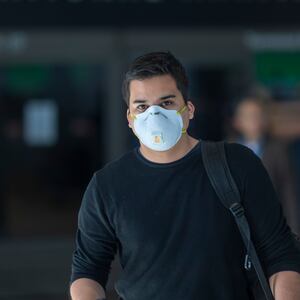HONG KONG—The new coronavirus that has spread consternation around the world over the last few weeks has now killed more people in China than the SARS epidemic of 2002-2003. China’s health commission reported Sunday that there were 361 deaths nationwide. During the SARS outbreak, 349 people died in mainland China and 774 altogether around the world. The Chinese stock markets took major hits Monday, and the whole nation feels its growing isolation.
Yet last December—before people all over China began falling sick with pneumonia-like symptoms, before people around the world grew alarmed about a disease leaping from captured wild animals to human shoppers in dense Chinese food markets, and before the coronavirus reached new shores after being carried onto planes by human hosts, forcing the World Health Organization to declare a global emergency—eight people discussed how several patients in Wuhan were experiencing severe, rapid breakdowns in their respiratory systems.
They were part of a medical school’s alumni group on WeChat, a popular social network in China, and they were concerned that SARS, Severe Acute Respiratory Syndrome, was back.
It wasn’t long before police detained them. The authorities said these eight doctors and medical technicians were “misinforming” the public, that there was no SARS, that the information was obviously wrong, and that everyone in the city must remain calm. On the first day of 2020, Wuhan police said they had “taken legal measures” against the eight individuals who had “spread rumors.”
Since then, the phenomenal spread of the virus has created cracks even within the normally united front of the Chinese Communist Party. “It might have been fortunate if the public had believed the ‘rumor’ and started to wear masks, carry out sanitization measures, and avoid the wild animal market,” a judge of China’s Supreme People’s Court wrote online last Tuesday.
Li Wenliang, a doctor who was among the eight people who tried to sound the alarm before the coronavirus infected many thousands and killed hundreds, has been diagnosed as someone infected with the coronavirus and is being treated at a hospital.
As of 5 p.m. Monday, the official tally of coronavirus damage runs at more than 17,000 confirmed infections, more than 21,000 under observation, and 361 dead. But the actual numbers must be far higher, possibly by a considerable magnitude, according to estimates by doctors in China and infectious-disease experts around the world.
Authorities are still actively censoring social-media posts and news articles that question the government's response to the outbreak. One Wuhan man, Fang Bin, uploaded footage of corpses in a van and a hospital in Wuhan, and was then tracked down and taken into custody. His laptop was confiscated, and he had to pedal for three hours on a bicycle to get home after he was questioned, warned, and released. His coronavirus video went viral.
The Chinese government is eager to project the image that everything is under control. Beijing pushed back the post-Lunar New Year opening of financial markets by a few days, and traders returned to their posts Monday morning. The Shanghai Composite Index and Shenzhen Composite Index quickly dropped 8.7 percent and 8.6 percent, respectively. By lunch time, more than 2,600 stocks had tripped regulator-imposed breakers after losing 10 percent in value. At market closing at 3 p.m., the indices were unable to recover from their nosedives.
This was the worst plummet in China’s markets since an equity bubble burst in 2015, and it isn’t difficult to see why. Schools have been closed indefinitely. Flights have been grounded, and domestic travel has been limited or even halted. Office buildings, restaurants, and malls are empty. Public functions have been canceled. Overwhelmingly, white-collar workers across the country are telecommuting. The country, it seems, is a network of ghost towns with wide boulevards and glass towers. Combined with the ongoing swine flu and a new outbreak of avian flu south of Wuhan, the coronavirus is hitting China’s economy on many fronts.
Perhaps the most striking development in China is how borders became tangible. Villages, towns, and cities are physically blocked off from each other, sometimes with local officials posted on roads to stop anyone except emergency relief personnel from passing through. Married couples who hail from different parts of the country have been separated if they chose to travel over the Lunar New Year; as they returned home after the break, local officials in some locations barred one spouse, whoever is an “outlander,” from entering city limits.
The coronavirus is isolating China from the rest of the world, too. Many countries have imposed travel restrictions on Chinese nationals, or even banned visitors who have recently been in mainland China.
In Hong Kong, medical workers who joined a newly formed union voted to begin a strike Monday to pressure the city’s officials to seal the border with mainland China. Clashes have broken out at sites where the government had attempted to set up mass quarantine facilities in Hong Kong.
Back in Wuhan, one of two speed-built hospitals began absorbing patients on Monday. The hospital took 10 days to build, has 1,000 beds, and is staffed by 1,400 military doctors who are managing the symptoms of those under their care. The additions are welcome, but people living in Hubei, the province where Wuhan is the capital, have doubts about how effective the facilities will be. There’s a severe shortage of testing kits, and sick people are still being turned away from hospitals. It is common for patients to wander between several emergency rooms before giving up to head home and tough it out.
This outbreak has given new meaning to a well-worn adage: When China sneezes, the world catches a cold. People recall a lack of transparency when SARS was hitting China, even though the WHO has praised Beijing repeatedly for improving its performance this time around. But that may not be enough. Right now, every country in the world is trying to prevent the epidemic from flaring up on its own shores.








